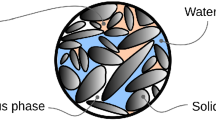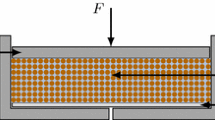Abstract
This paper presents a computational framework for the numerical analysis of fluid-saturated porous media at large strains. The proposal relies, on one hand, on the particle finite element method (PFEM), known for its capability to tackle large deformations and rapid changing boundaries, and, on the other hand, on constitutive descriptions well established in current geotechnical analyses (Darcy’s law; Modified Cam Clay; Houlsby hyperelasticity). An important feature of this kind of problem is that incompressibility may arise either from undrained conditions or as a consequence of material behaviour; incompressibility may lead to volumetric locking of the low-order elements that are typically used in PFEM. In this work, two different three-field mixed formulations for the coupled hydromechanical problem are presented, in which either the effective pressure or the Jacobian are considered as nodal variables, in addition to the solid skeleton displacement and water pressure. Additionally, several mixed formulations are described for the simplified single-phase problem due to its formal similitude to the poromechanical case and its relevance in geotechnics, since it may approximate the saturated soil behaviour under undrained conditions. In order to use equal-order interpolants in displacements and scalar fields, stabilization techniques are used in the mass conservation equation of the biphasic medium and in the rest of scalar equations. Finally, all mixed formulations are assessed in some benchmark problems and their performances are compared. It is found that mixed formulations that have the Jacobian as a nodal variable perform better.











Similar content being viewed by others
References
Abbo AJ, Lyamin AV, Sloan SW, Hambleton JP (2011) A C2 continuous approximation to the Mohr–Coulomb yield surface. Int J Solids Struct 48(21):3001–3010
Babuška I (1971) Error-bounds for finite element method. Numer Math 16(4):322–333
Bathe KJ (2010) The inf-sup condition and its evaluation for mixed finite element methods. Comput Struct 79(2):243–252
Bochev PB, Dohrmann CR, Gunzburger MD (2008) Stabilization of low-order mixed finite elements for the Stokes equations. SIAM J Numer Anal 44:82–101
Borja RI, Alarcón E (1995) A mathematical framework for finite strain elastoplastic consolidation Part 1: balance laws, variational formulation, and linearization. Comput Methods Appl Mech Eng 122(1–2):145–171
Borja RI, Tamagnini C (1998) Cam-Clay plasticity part III: extension of the infinitesimal model to include finite strains. Comput Methods Appl Mech Eng 155(1–2):73–95
Borja RI, Tamagnini C, Alarcón E (1998) Elastoplastic consolidation at finite strain part 2: finite element implementation and numerical examples. Comput Methods Appl Mech Eng 159(1–2):103–122
Brezzi F (1974) On the existence, uniqueness and approximation of saddle-point problems arising from Lagrangian multipliers. Rev française d’automatique Inf rech Opér. Anal numérique 8(2):129–151
Carbonell JM (2009) Modeling of ground excavation with the particle finite element method. PhD thesis, Universitat Politècnica de Catalunya (UPC), Barcelona
Carbonell JM, Oñate E, Suárez B (2010) Modeling of ground excavation with the particle finite-element method. J Eng Mech 136(4):455–463
Dohrmann CR, Bochev PB (2004) A stabilized finite element method for the Stokes problem based on polynomial pressure projections. Int J Numer Methods Fluids 46:183–201
Edelsbrunner H, Mucke EP (1994) Three dimensional alpha shapes. ACM Trans Graph 13:43–72
Houlsby GT (1985) The use of variable shear modulus in elastic-plastic models for clays. Comput Geotech 1(1):3–13
Kardani M, Nazem M, Carter JP, Abbo AJ (2015) Efficiency of high-order elements in large-deformation problems of geomechanics. Int J Geomech 15(6):04014101
Larese A, Rossi R, Oñate E, Idelsohn SR (2012) A coupled PFEM-Eulerian approach for the solution of porous FSI problems. Comput Mech 50(6):805–819
Larsson J, Larsson R (2002) Non-linear analysis of nearly saturated porous media: theorical and numerical formulation. Comput Methods Appl Mech Eng 191:3885–3907
Monforte L, Arroyo M, Carbonell JM, Gens A (2017) Numerical simulation of undrained insertion problems in geotechnical engineering with the particle finite element method (PFEM). Comput Geotech 82:144–156
Monforte L, Arroyo M, Gens A, Carbonell JM (2014) Explicit finite deformation stress integration of the elastic-plastic constitutive equations. Computer methods and recent advances in geomechanics—proceedings of the 14th international conference of IACMAG, pp. 267–272
Oliver J, Cante JC, Weyler R, González C, Hernandez H (2007) Particle finite element methods in solid mechanics problems. In: Oñate E, Owen R (eds) Computational plasticity, vol 7. Springer, Dordrecht, pp 87–103
Oñate E, Idelsohn SR, Del Pin F, Aubry R (2004) The particle finite element method-an overview. Int J Comput Methods 1(2):267–307
Oñate E, Rojek J, Taylor RL, Zienkiewicz OC (2004) Finite calculus formulation for incompressible solids using linear triangles and tetrahedra. Int J Numer Methods Eng 59(11):1473–1500
Pastor M, Li T, Liu X, Zienkiewicz OC, Quecedo M (2000) A fractional step algorithm allowing equal order of interpolation for coupled analysis of saturated soil problems. Mech Cohesive Frict Mater 5(7):511–534
Preisig M, Prévost JH (2011) Stabilization procedures in coupled poromechanics problems: A critical assessment. Int J Numer Anal Methods Geomech 35(11):1207–1225
Potts DM, Zdravković L (1999) Finite element analysis in geotechnical engineering, vol 1. Thomas Teldford, London
Rashid MM (2002) Material state remapping in computational solid mechanics. Int J Numer Methods Eng 55:431–450
Raviart PA, Thomas JM (1977) A mixed finite element method for 2-nd order elliptic problems. Springer, Berlin
Robertson PK (2009) Interpretation of cone penetration tests-a unified approach. Can Geotech J 46(11):1337–1355
Rodriguez JM, Carbonell JM, Cante JC, Oliver J (2016) The particle finite element method (PFEM) in thermo-mechanical problems. Int J Numer Methods Eng. doi:10.1002/nme.5186
Rouainia M, Wood DM (2006) Computational aspects in finite strain plasticity analysis of geotechnical materials. Mech Res Commun 33(2):123–133
Salazar F, Irazábal J, Larese A, Oñate E (2016) Numerical modelling of landslide-generated waves with the particle finite element method (PFEM) and a non-Newtonian flow model. Int J Numer Anal Methods Geomech 40:809–836
Sheng D, Kelly R, Pineda J, Lachlan B (2014) Numerical study of rate effects in cone penetration test. In 3rd international symposium on cone penetration testing, pp. 419–428
Simo JC (1998) Numerical analysis and simulation of plasticity. In: Ciarlet P, Lions J (eds) Handbook of numerical analysis, vol VI. North-Holland, Amsterdam, pp 183–499
Simo JC, Hughes TJR (1998) Computational inelasticity. Springer, New York
Sloan SW, Abbo AJ, Sheng D (2001) Refined explicit integration of elastoplastic models with automatic error control. Eng Comput 18(1–2):121–194
de Souza Neto EA, Perić D, Dutko M, Owen DRJ (1996) Design of simple low order finite elements for large strain analysis of nearly incompressible solids. Int J Solids Struct 33(20):3277–3296
Sun WC, Ostien JT, Salinger AG (2013) A stabilized assumed deformation gradient finite element formulation for strongly coupled poromechanical stimulations at finite strains. Int J Numer Anal Methods Geomech 37:2755–2788
Sun WC, Chen Q, Ostien JT (2013) Modeling the hydro-mechanical responses of strip and circular punch loadings on water-saturated collapsible geomaterials. Acta Geotech 9(5):903–934
Taylor C, Hood P (1973) A numerical solution of the Navier–Stokes equations using the finite element technique. Comput Fluids 1(1):73–100
Truty A, Zimmermann T (2006) Stabilized mixed finite element formulations for materially nonlinear partially saturated two-phase media. Comput Methods Appl Mech Eng 195(13):1517–1546
Zhang X, Krabbenhoft K, Sheng D, Li W (2015) Numerical simulation of a flow-like landslide using the particle finite element method. Comput Mech 55(1):167–177
Zienkiewicz OC, Taylor RL (2000) The finite element method: solid mechanics, vol 2. Butterworth-heinemann, Oxford
Acknowledgements
The support of the Ministry of Economy of Spain through research Grants BIA2011-27217 and BIA2014-59467-R is gratefully acknowledged.
Author information
Authors and Affiliations
Corresponding author
Rights and permissions
About this article
Cite this article
Monforte, L., Carbonell, J.M., Arroyo, M. et al. Performance of mixed formulations for the particle finite element method in soil mechanics problems. Comp. Part. Mech. 4, 269–284 (2017). https://doi.org/10.1007/s40571-016-0145-0
Received:
Revised:
Accepted:
Published:
Issue Date:
DOI: https://doi.org/10.1007/s40571-016-0145-0




